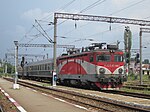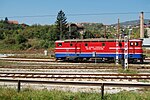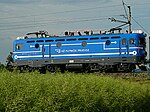JŽ series 441
This article needs additional citations for verification. (August 2016) |
| JŽ series 441 | |||||||||||||||||
|---|---|---|---|---|---|---|---|---|---|---|---|---|---|---|---|---|---|
 ŽS 441-704 prior to refurbishment, with the EuroCity 344 Avala (Belgrade-Prague) awaiting to leave Belgrade Main towards Subotica, 10 September 2010 | |||||||||||||||||
| |||||||||||||||||
| |||||||||||||||||
| |||||||||||||||||
| |||||||||||||||||
The JŽ series 441 is an electric locomotive built for Yugoslav Railways. The units are now used by Hrvatske željeznice (HŽ series 1141), Željeznice Federacije Bosne i Hercegovine, Željeznice Republike Srpske, Železnice Srbije and rail transport of TPP Nikola Tesla (ŽS 441), Makedonski Železnici, Turkish State Railways and Romanian Railways-CFR.
History
[edit]This series is originally based on the license of the Swedish company ASEA and the SJ Rb locomotive from Sweden. It was produced in order to be used as a universal locomotive, for both passenger and freight traffic on mainline electrified routes. There was also a need to have a powerful electric locomotive to pull freight. Originally, it had diode voltage selector. A later, modernised series, the 3xx subseries, include thyristor voltage selector, and an on-board computer. Later 3xx series have an onboard look-behind-camera for video surveillance of the sides and also new livery.
Voltage
[edit]This locomotive utilises 25 kV/50 Hz AC.
Gearing
[edit]Depending on subseries, 1xx, 2xx or 3xx, different members of this class have a top speed of 120 km/h (75 mph) or 140 km/h (87 mph), depending on the gearing. The more common gearing is the 120 km/h (75 mph) (classes 0xx, 1xx, 2xx, 3xx, 4xx, 5xx, 8xx) intended for freight and passenger trains, while the 140 km/h (87 mph) (classes 6xx and 7xx), intended for passenger services, was only installed in the final batch of series 441 locomotives (consisting of the 6xx and 7xx subseries). The models with higher maximum speed have lower tractive power and are used for passenger or light freight trains only, whereas the models with lower maximum speed have high tractive power and are thus able to pull heavy freight trains.
Liveries
[edit]Original livery of Yugoslav Railways was red (occasionally orange) and blue with white stripe and "Jugoslovenske železnice" inscription on it. Serbian Railways class 441 units were later recolored into a red and grey livery. Post-overhaul units owned by Srbija Voz are colored in the new "swoosh" livery shared with Stadler FLIRT EMUs, while unoverhauled and Srbija Kargo units retain the red and grey color scheme.
Locomotives of Republika Srpska have similar livery as the original Yugoslav, but with faded colours and a white stripe between blue and red.
In Croatia, there are three basic liveries. The standard one is the red with white stripe. There is also a very rare livery, in colours similar to Croatian flag. The third, newest livery is the HŽ official livery (red and grey with blue stripe).
The Romanian Railways' original livery was in grey with a red or blue stripe, some examples even with the Romanian tricolor flag used instead of the blue or red stripe (similar case to a few members of EA class), but after 2000, the traditional white-red (front ends) livery has been applied. A reversed variation of it appeared on the 3 Class 46 locomotives modernized in Croatia, whilst for the rest Class 46 members, the livery is similar to the ones applied on the Class 47 locomotives.
-
Sketch of the original Yugoslav Railways livery
-
Serbian Railways standard livery
-
Sketch of the new "HŽ vuča vlakova" livery
-
ŽRS standard livery
-
Sketch of the ŽFBiH special livery
-
Sketch of the ŽFBiH livery
Export
[edit]
Starting with 1972, between Yugoslavia and Romania a convention was concluded for reciprocal delivery for locomotives. It also involved the Romanian companies Electroputere Craiova and UCM Reşiţa. Thus the Romanian party delivered to Yugoslavia a number of 103 Co’Co locomotives of the 461 JŽ series and sub-assemblies for 130 Bo’Bo locomotives of the 441 JŽ series, delivered to Romania and registered with CFR under the number 040-EC (Class 43) between 1973 and 1984. The Yugoslavian locomotives derived directly from the already renowned prototype ASEA RB1 improved in the mechanical construction under the RC1 series pattern.[1][2] A number of locomotives have been modernised to Class 46, initially 3 units by Končar Group, and later by PROMAT and Softronic Craiova. Class 46 is also a number used by Class 43/44 locomotives that were reclassified after being renumbered into UIC system, though with no modernisation what so ever. The Class 44 (040-EC1) is the same as Class 43, but modified for higher speeds (160 km/h).
Since the dissolution of SFRY, this locomotive is also exported. Some pieces are in North Macedonia, and some were leased to Turkish Railways (as TCDD E52500 class). Now, most of the former Republics which have been formed after the dissolving of Yugoslavia have some of these locomotives, inherited from the former JŽ. These units have different designations, but very similar characteristics.
In popular culture
[edit]One example made an appearance coming out of a tunnel towards the end of the movie Force 10 From Navarone. This is anachronistic as the movie took place during World War II.
Gallery
[edit]-
Serbian Railways' unrefurbished 441-704 between Subotica and Novi Sad
-
Serbian Railways' refurbished 441-704 at Belgrade Main before closure
-
The same series (modified and renumbered) at Turkish National Railways.
-
Alternative, rare livery.
-
ŽFBH class 441
-
ŽRS class 441
-
CFR Class 43 (here seen as reclassified into Class 46)
-
CFR Class 46 (Končar modernisation)
-
CFR Class 46 (PROMAT modernisation)
-
TENT Class 441
-
ŽFBH 441-307 (Kakanj)
-
HŽ 1 141 303, older livery
-
HŽPP series 1141, new livery in blue
References
[edit]- ^ An electric locomotive for CFR and not only…. Archived June 11, 2011, at the Wayback Machine
- ^ "An electric locomotive for CFR and not only….Sequel". Archived from the original on 2011-06-11. Retrieved 2010-04-07.
External links
[edit]- Electric locomotives of Yugoslavia
- Bo′Bo′ locomotives
- 25 kV AC locomotives
- Railway locomotives introduced in 1968
- Electric locomotives of Bosnia and Herzegovina
- Electric locomotives of Croatia
- Electric locomotives of North Macedonia
- Electric locomotives of Serbia
- Standard gauge locomotives of Croatia
- Standard gauge locomotives of Bosnia and Herzegovina
- Standard gauge locomotives of Serbia
- Standard gauge locomotives of North Macedonia
- Standard gauge locomotives of Turkey
- Standard gauge locomotives of Romania

















